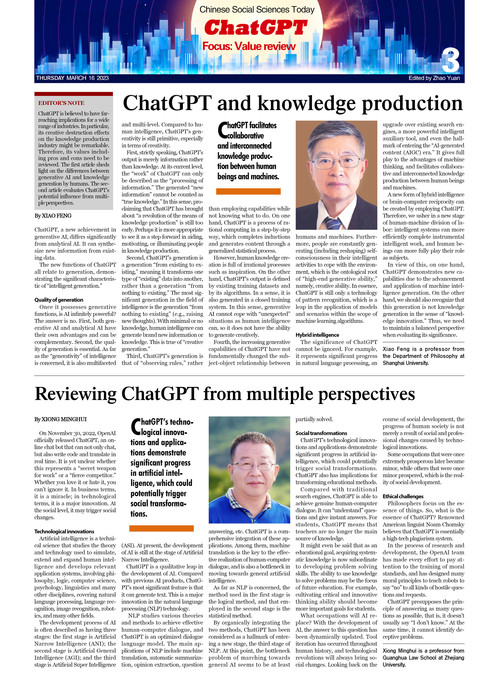Reviewing ChatGPT from multiple perspectives
2023-03-16 14:00:59
By XIONG MINGHUI
On November 30, 2022, OpenAI officially released ChatGPT, an online chat bot that can not only chat, but also write code and translate in real time. It is yet unclear whether this represents a “secret weapon for work” or a “fierce competitor.” Whether you love it or hate it, you can’t ignore it. In business terms, it is a miracle; in technological terms, it is a major innovation. At the social level, it may trigger social changes.
Technological innovations
Artificial intelligence is a technical science that studies the theory and technology used to simulate, extend and expand human intelligence and develops relevant application systems, involving philosophy, logic, computer science, psychology, linguistics and many other disciplines, covering natural language processing, language recognition, image recognition, robotics, and many other fields.
The development process of AI is often described as having three stages: the first stage is Artificial Narrow Intelligence (ANI); the second stage is Artificial General Intelligence (AGI); and the third stage is Artificial Super Intelligence (ASI). At present, the development of AI is still at the stage of Artificial Narrow Intelligence.
ChatGPT is a qualitative leap in the development of AI. Compared with previous AI products, ChatGPT’s most significant feature is that it can generate text. This is a major innovation in the natural language processing (NLP) technology.
NLP studies various theories and methods to achieve effective human-computer dialogue, and ChatGPT is an optimized dialogue language model. The main applications of NLP include machine translation, automatic summarization, opinion extraction, question answering, etc. ChatGPT is a comprehensive integration of these applications. Among them, machine translation is the key to the effective realization of human-computer dialogue, and is also a bottleneck in moving towards general artificial intelligence.
As far as NLP is concerned, the method used in the first stage is the logical method, and that employed in the second stage is the statistical method.
By organically integrating the two methods, ChatGPT has been considered as a hallmark of entering a new stage, the third stage of NLP. At this point, the bottleneck problem of marching towards general AI seems to be at least partially solved.
Social transformations
ChatGPT’s technological innovations and applications demonstrate significant progress in artificial intelligence, which could potentially trigger social transformations. ChatGPT also has implications for transforming educational methods.
Compared with traditional search engines, ChatGPT is able to achieve genuine human-computer dialogue. It can “understand” questions and give instant answers. For students, ChatGPT means that teachers are no longer the main source of knowledge.
It might even be said that as an educational goal, acquiring systematic knowledge is now subordinate to developing problem solving skills. The ability to use knowledge to solve problems may be the focus of future education. For example, cultivating critical and innovative thinking ability should become more important goals for students.
What occupations will AI replace? With the development of AI, the answer to this question has been dynamically updated. Tool iteration has occurred throughout human history, and technological revolutions will always bring social changes. Looking back on the course of social development, the progress of human society is not merely a result of social and professional changes caused by technological innovations.
Some occupations that were once extremely prosperous later became minor, while others that were once minor prospered, which is the reality of social development.
Ethical challenges
Philosophers focus on the essence of things. So, what is the essence of ChatGPT? Renowned American linguist Noam Chomsky believes that ChatGPT is essentially a high-tech plagiarism system.
In the process of research and development, the OpenAI team has made every effort to pay attention to the training of moral standards, and has designed many moral principles to teach robots to say “no” to all kinds of hostile questions and requests.
ChatGPT presupposes the principle of answering as many questions as possible, that is, it doesn’t usually say “I don’t know.” At the same time, it cannot identify deceptive problems.
Xiong Minghui is a professor from Guanghua Law School at Zhejiang University.



